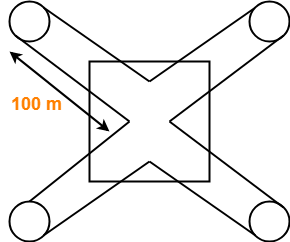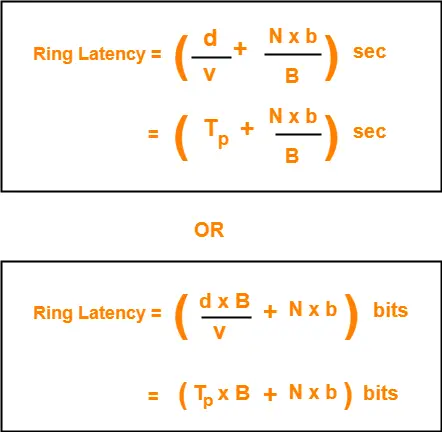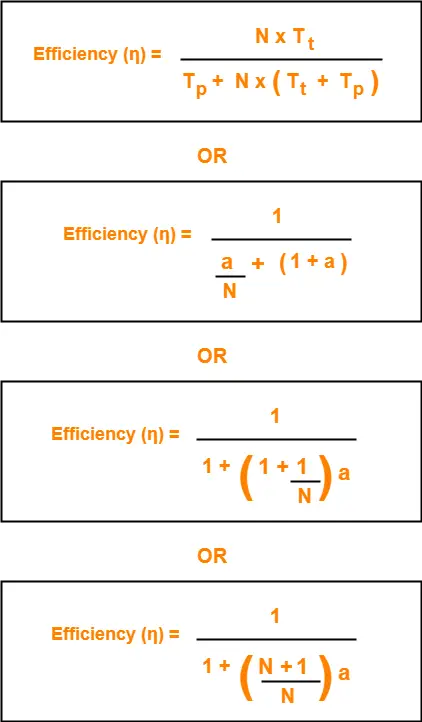PRACTICE PROBLEMS BASED ON TOKEN RING AND TOKEN PASSING-
Before you go through this article, make sure that you have gone through the previous article on Token Passing.
Problem-01:
Token ring station operates in which of the following modes?
- Transit mode
- Listen mode
- Bypass mode and Receive mode
- All of the above
Solution-
- In transmit mode, a station transmits the data.
- In listen mode, a station listens from other station(s).
- In bypass mode, a station simply bypasses the data packet if it is not meant for it.
- In receive mode, a station receives the data packet if it is destined to it.
Therefore, a token ring station operates in all these modes.
Thus, Option (D) is correct.
Problem-02:
Efficiency of the token ring is high if-
- Reinsert the token after receiving the last bit of the frame
- Reinsert the token after receiving the last bit of the header
- Reinsert the token after last bit of the data packet is transferred
- Reinsert the token after last bit of the header is transferred
Solution-
- There are two strategies used in token ring- Early Token Reinsertion (ETR) and Delayed Token Reinsertion (DTR).
- Efficiency of token ring is high in Early Token Reinsertion (ETR).
Thus, Option (C) is correct.
Problem-03:
The sending station in IEEE 802.5 sets the address recognized (A) bit and frame copied (C) bit in MAC header as
- 1,0
- 0,0
- 0,1
- 1,1
Solution-
- IEEE 802.5 is token ring.
- Sending station sets both the available bit and copied bit as 0.
- These bits are modified by the receiving station.
- If the receiving station is available, it sets the Available bit to 1.
- If the receiving station successfully copies the data, it sets the Copied bit to 1.
Thus, Option (B) is correct.
Problem-04:
Which of the following fields in 802.5 MAC header is not included in CRC or FCS?
- FC
- Data field
- FS
- SA
Solution-
- IEEE 802.5 is token ring.
- Frame Status (FS) field consists of the Available bit and Copied bit.
- These two bits are modified by the receiving station.
- So, CRC is not computed on Frame Status field otherwise receiving station will have to bear the overhead of recomputing the CRC.
Thus, Option (C) is correct.
Problem-05:
What type of acknowledgement system is used in 802.5?
- Cumulative ACK
- Independent ACK
- Piggybacking ACK
- None
Solution-
- IEEE 802.5 is token ring.
- The two bits- Available bit and Copied bit acts as the acknowledgement for the sending station.
- The value of these bits suggests to the sending station that whether the receiving station has successfully copied the data or not.
- Because the two bits are contained in the data frame, so we can say that piggybacked acknowledgements are used in token ring.
Thus, Option (C) is correct.
Problem-06:
In token ring, ______ field is present only in the data / command frame but not in the token frame.
- SD
- AC
- ED
- FS
Solution-
- Frame status (FS) field is present only in the data / command frame.
- A token frame consists of only 3 fields- SD, AC and ED.
Thus, Option (D) is correct.
Problem-07:
Consider a token ring with latency 500 μsec and packet size of 1500 bytes. What is the effective throughput rate for both single active host and for many active hosts that can be achieved if the ring has 3 Mbps bandwidth? Assume the strategy used is delayed token reinsertion.
- 2.4 Mbps and 3 Mbps
- 2.4 Mbps and 2 Mbps
- 2 Mbps and 3 Mbps
- 2.4 Mbps and 2.67 Mbps
Solution-
Given-
- Ring latency = 500 μsec
- Packet Size = 1500 bytes
- Bandwidth = 3 Mbps
- Strategy used is Delayed Token Reinsertion (DTR)
Efficiency of Delayed Token Reinsertion (DTR) strategy is-

Calculating Transmission delay-
We know,
Transmission delay (Tt)
= Packet size / Bandwidth
= 1500 bytes / 3 Mbps
= (1500 x 8 bits) / (3 x 106 bits per sec)
= 4000 μsec
Calculating value of ‘a’-
We know,
a = Tp / Tt
a = Latency / Tt
a = 500 μsec / 4000 μsec
a = 0.125
Calculating Throughput for single active host-
For single active host, N = 1.
Substituting N = 1 in efficiency formula, we get-
Efficiency (η)
= 1 / (1 + 2a)
= 1 / (1 + 2 x 0.125)
= 1 / 1.25
= 0.8
Now,
Throughput
= Efficiency (η) x Bandwidth
= 0.8 x 3 Mbps
= 2.4 Mbps
Calculating Throughput for many active host-
For many active host, N = ∞.
Substituting N = ∞ in efficiency formula, we get-
Efficiency (η)
= 1 / (1 + a)
= 1 / (1 + 0.125)
= 1 / 1.125
= 0.89
Now,
Throughput
= Efficiency (η) x Bandwidth
= 0.89 x 3 Mbps
= 2.67 Mbps
Thus, Option (D) is correct.
Problem-08:
In 802.5, the condition to find out the minimum size of the ring is-
- Latency of the ring = Transmission delay of the data frame
- Latency of the ring = Transmission delay of the token frame
- Latency of the ring = RTT
- Latency > RTT
Solution-
- IEEE 802.5 is token ring.
- The condition to find out the minimum size of the ring is-
Latency of the ring >= Transmission delay of the token frame
- In worst case, all the stations goes down and only the monitor station is alive.
- Monitor station sends the token and the token comes back to it.
- To avoid the collision between the first and the last bit of the token, propagation delay of the token must be at least equal to its transmission delay.
Thus, Option (B) is correct.
Problem-09:
The stacking station is a station in 802.5 and it can be described as-
- when it drains the frame and creates a token, it then stores both the old and new priority of the token
- A station which stack the token till it gets the last bit of the token
- It is nothing but monitor station
- None of the above
Solution-
- IEEE 802.5 is token ring.
- A station which increases the priority of the token should next decrease the priority of the token.
- Otherwise once the priority of the token reaches the highest value, it would ever remain there and thus only the station with the highest packet would drain (take) the token and use it.
- Thus, a stacking station must remember both the old and new priorities so that when it later receives the token with new priority, it changes it to old priority.
- This is implemented by using 2 stacks. Each station maintains 2 stacks where one station keeps track of the old priority and other stack keeps track of the new priority.
Thus, Option (A) is correct.
Problem-10:
In early token release, the station releases a token as soon as it completes the frame transmission whether or not the frame header has returned to the station, then what will be the priority of the token released?
- The priority in the frame that completes frame transmission
- Without changing the priority, token will be released
- Default priority is used
- The priority in the reservation field of the most recently received frame
Solution-
Option (D) is correct.
Problem-11:
Find the efficiency of the ring where data rate of the link is 4 Mbps, number of stations are 20, separated by 100 meters and bit delay in each station is 2.5 bits. Assume early token reinsertion with packet size of 1000 bits and transmission speed is 2 x 108 m/sec.
Solution-
Given-
- Data rate = Bandwidth = 4 Mbps
- Number of stations = 20
- Distance between two stations = 100 meters
- Bit delay = 25 bits
- Packet size = 1000 bits
- Strategy used is Early Token Reinsertion (ETR)
Calculating length of ring wire-
Total length of ring wire
= Number of stations x Distance between 2 stations
= 20 x 100 meters
= 2000 meters
= 2 km
Calculating Transmission delay-
Transmission delay (Tt)
= Packet size / Bandwidth
= 1000 bits / 4 Mbps
= 1000 bits / (4 x 106 bits per sec)
= 250 μsec
Calculating Propagation delay-
Propagation delay (Tt)
= Distance / Speed
= 2 km / (2 x 108 m/sec)
= (2 x 103 m) / (2 x 108 m/sec)
= 10-5 sec
= 10 μsec
Calculating Bit delay in seconds-
Bit delay
= 25 bits
= 2.5 bits / 4 Mbps
= 25 bits / (4 x 106 bits per sec)
= 0.625 μsec
Calculating Ring latency-
Ring latency
= Propagation delay + N x Bit delay
= 10 μsec + 20 x 0.625 μsec
= 10 μsec + 12.5 μsec
= 22.5 μsec
Calculating value of ‘a’-
a
= Ring latency / Tt
= 22.5 μsec / 250 μsec
= 0.09
Calculating Efficiency-
Efficiency(η)
= 1 / (1 + a/N)
= 1 / (1 + 0.09 / 20)
= 1 / 1.0045
= 0.9955
= 99.55%
Problem-12:
A token ring LAN network interconnects M stations using Star Topology in the following way. All the input and output lines of the token ring station interface are connected to a cabinet where the actual ring is placed. Suppose that distance from each station to a cabinet is 100 m and ring latency per station is 8 bits, packets are 1250 B and bandwidth is 25 Mbps.
- Find the ring latency normalized to packet transmission time.
- Find the minimum number of packets transmitted by stations, if stations are allowed to transmit an unlimited number of packet / token. (v = 2 x 108 m/sec)
Solution-
Based on the given information, the token ring LAN network looks like-

(The sketch is for 4 stations)
Part-01:
Calculating Transmission delay-
Transmission delay
= Packet size / Bandwidth
= 1250 B / 25 Mbps
= (1250 x 8 bits) / (25 x 106 bits per sec)
= 400 μsec
Calculating Propagation delay-
Propagation delay
= Distance / Speed
= (200 x M meters) / (2 x 108 m/sec)
= (200 x M) / (2 x 108) sec
= 100 x M x 10-8 sec
= M μsec
Calculating Bit delay in seconds-
Bit delay
= Ring latency per station
= 8 bits
= 8 bits / 25 Mbps
= 0.32 μsec
Calculating Ring latency-
Ring latency
= Propagation delay + N x Bit delay
= M μsec + M x 0.32 μsec
= 1.32 x M μsec
Calculating Ring latency normalized to packet transmission delay-
Ring latency normalized to packet transmission time
= Ring latency / Packet transmission time
= 1.32 x M μsec / 400 μsec
= 0.0033 x M
Part-02:
- The number of packets a station can transmit after holding a token depends on Token Holding Time and the strategy used.
- Since no information is given in the question about the Time Holding Time, so we assume that there is no restriction on holding the token.
- Thus, a station can send infinite number of packets after getting a token.
Problem-13:
A very heavily loaded 1 km long, 10 Mbps token ring has a propagation speed of 200 m/μsec. 50 stations are uniformly spaced around the ring. Data frames are 256 bits including 32 bits of overhead. Acknowledgements are piggybacked onto the data frames and are thus included as spare bits within the data frames and are effectively free. The token is 8 bits long. Is the effective data rate of this ring higher or lower than the effective data rate of a 10 Mbps CSMA / CD network? Assume ‘Early Token Release’ policy.
Solution-
RememberToken Ring always beats the Ethernet in terms of effective bandwidth. |
Analysis-
Efficiency of CSMA / CD-
Efficiency of token ring in early token retransmission is given by-
Efficiency(η) = 1 / (1 + 6.44 x a)
This expression is valid when number of stations are very large i.e. N → ∞
Efficiency of Token Ring-
Case-01:
Efficiency of token ring in early token retransmission is given by-
Efficiency(η) = 1 / (1 + a/N)
When N → ∞, Efficiency(η) = 100%
Case-02:
Efficiency of token ring in delayed token retransmission is given by-
Efficiency(η) = 1 / [1 + a(1 + 1/N)]
When N → ∞, Efficiency(η) = 1 / (1+a)
The above analysis clearly shows-
Efficiency of Token Ring in ETR > Efficiency of Token Ring in DTR > Efficiency of Token Ring in CSMA / CD.
Problem-14:
A fibre optic token ring used as a MAN is 200 km long and runs at 100 Mbps. After sending a frame, a station drains the frame from the ring before regenerating the token. The signal propagation speed in the fibre is 200,000 km/sec and maximum frame size is 1 KB. What is the maximum efficiency at N=1?
Solution-
Given-
- Distance = 200 km
- Bandwidth = 100 Mbps
- Propagation speed = 200,000 km/sec = 2 x 108 m/sec
- Frame size = 1 KB
- Number of stations = 1
- Strategy used is Delayed Token Reinsertion
Calculating Transmission delay-
Transmission delay
= Frame size / Bandwidth
= 1 KB / 100 Mbps
= (1 x 210 x 8 bits) / (100 x 106 bits per sec)
= 81.92 μsec
Calculating Propagation delay-
Propagation delay
= Distance / Speed
= 200 km / (2 x 108 m/sec)
= (200 x 103 m) / (2 x 108 m/sec)
= 10-3 sec
= 1 msec
Calculating value of ‘a’-
a
= Tp / Tt
= 1 msec / 81.92 μsec
= 0.0122 x 103
= 12.2
Calculating Efficiency-
Efficiency(η)
= 1 / [1 + a x (1+ 1/N)]
= 1 / [1 + 12.2 x (1+1)]
= 1 / 25.4
= 0.0394
= 3.94%
- The reason behind this much less efficiency is that the distance is too large here.
- Ethernet and Token Ring are meant for LANs.
- If used for MANs or WANs, the efficiency will fall drastically.
Problem-15:
At a propagation speed of 200 m/μsec, what is the effective length added to a ring by a bit delay at each repeater or station for-
- 1 Mbps line
- 40 Mbps line
Solution-
Part-01:
Effective length added to a ring by a bit delay
= 1 bit / 1 Mbps
= 1 μsec
= 1 μsec x 200 m/μsec
= 200 m
Part-02:
Effective length added to a ring by a bit delay
= 1 bit / 40 Mbps
= 0.025 μsec
= 0.025 μsec x 200 m/μsec
= 5 m
Problem-16:
Consider a 10 Mbps token ring LAN with a ring latency of 400 μs. A host that needs to transmit seizes the toke. Then it sends a frame of 1000 bytes, removes the frame after it has circulated all around the ring and finally releases the token. This process is repeated for every frame. Assuming that only a single host wishes to transmit, the effective data rate is _____ .
- 1 Mbps
- 2 Mbps
- 5 Mbps
- 6 Mbps
Solution-
Given-
- Bandwidth = 10 Mbps
- Ring latency = 400 μsec
- Frame size = 1000 bytes
- Number of stations = 1
- Strategy used is Delayed Toke Reinsertion
Calculating Transmission delay-
Transmission delay
= Frame size / Bandwidth
= 1000 bytes / 10 Mbps
= (1000 x 8 bits) / (10 x 106 bits per sec)
= 800 μsec
Calculating value of ‘a’-
a
= Ring latency / Tt
= 400 μsec / 800 μsec
= 0.5
Calculating Efficiency-
Efficiency(η)
= 1 / [1 + a x (1+ 1/N)]
= 1 / [1 + 0.5 x (1+1)]
= 1 / 2
= 0.50
= 50%
Calculating Effective data rate-
Effective data rate
= Throughput
= Efficiency(η) x Bandwidth
= 0.5 x 10 Mbps
= 5 Mbps
Thus, Option (C) is correct.
Next Article- Aloha | Pure Aloha | Slotted Aloha
Get more notes and other study material of Computer Networks.
Watch video lectures by visiting our YouTube channel LearnVidFun.












